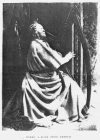

|

In the 19th century, the indigenous traditions of making and playing the old Irish harp, with metal wire strings, came to an end.
Also in the 19th century, a new type of instrument, based on Anglo-Continental classical pedal harp design and construction with gut strings and semitone mechanisms, was developed in Dublin by John Egan and marketed as the "portable Irish harp".
In the first half of the 19th century, a number of harp makers produced hybrid instruments. These have the metal wire stringing of the old Irish harps, but they have the built-up construction of Anglo-Continental classical harps, with a slender tapering soundboard, cross-grain softwood soundboard, and often bridge pins on a laminate or layered neck.
The best-known were made by John Egan, a Dublin pedal harp maker, and later by his nephew Francis Hewson, between 1820 and 1840. Other makers also made similar instruments at this time, copying Egan.
These instruments were of large high-headed design. Their soundboxes are built up in the style of pedal harp bodies; the neck and pillar being very plain and of a curious curving shape similar to Egan's “newly invented Portable harp” with gut strings, the predecessor of the modern lever harp. I am not sure how many are extant. Nancy Hurrell has been catalogueing the ones made by Egan, and has listed six extant examples, some in private collections and some in museums. There are also harps made by Egan's nephew, Frances Hewson, and others made by other makers copying Egan's design.

Joan Rimmer slated these instruments in her 1969 book as “nightmare parodies of the old Irish harp” and criticised their “peculiarly unattractive” tone. Her only concrete complaint was that their sound is “excessively long-lasting unless damped”. That long-lasting resoance seems to have been a desired feature of the old Irish harps, and is normal for harps with metal wire strings; and so it seems that Rimmer did not understand the Hybrid harps at all.
These large, wire-strung, Gaelic harps made by Egan for the Society are sometimes confused with Egan's smaller and earlier Royal Portable Irish harps, which have gut strings and mechanical semitone fretting devices. Both types were often decorated with golden shamrocks, and have a similar curving profile, but whereas the Society instruments were about 6 feet tall with brass wire strings and were made for the Irish Harp Society, for use by students learning Irish harp in the lineage of tradition-bearers back to the 18th century irish harpers, the Portable Irish harps were about 3 feet tall with gut strings and semitone mechanisms and were intended for middle and upper class Anglo-Irish whose harp playing and music was in an Anglo-Classical tradition.
Simon Chadwick